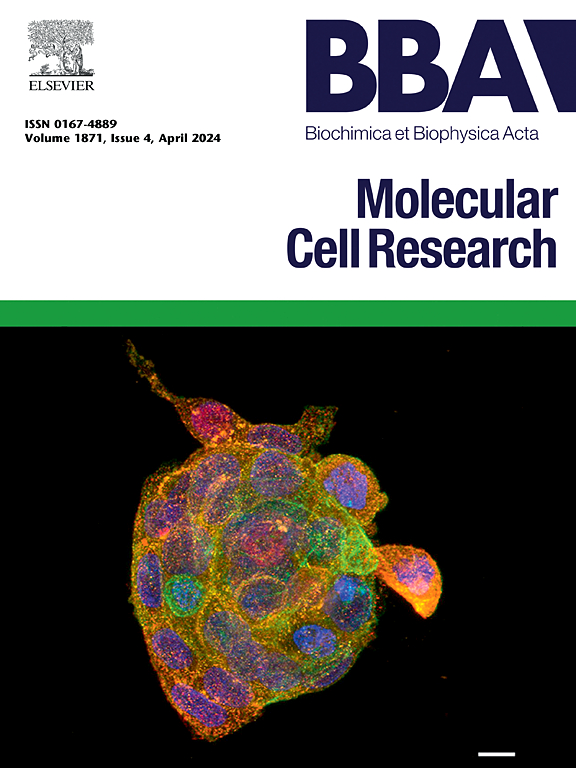Paraoxonase 3 regulates the pore-forming α subunit of the large-conductance K+ channel
IF 3.7
2区 生物学
Q1 BIOCHEMISTRY & MOLECULAR BIOLOGY
Biochimica et biophysica acta. Molecular cell research
Pub Date : 2025-05-12
DOI:10.1016/j.bbamcr.2025.119990
引用次数: 0
Abstract
Paraoxonase 3 (PON3) is expressed in the aldosterone-sensitive distal nephron (ASDN) where the fine tuning of Na+ and K+ homeostasis in the kidney occurs. Flow-induced K+ secretion within intercalated cells (ICs) of the ASDN is mediated by the large-conductance K+ (BK) channels. We have previously shown that renal PON3 expression was altered by dietary K+ intake and that Pon3 knockout (KO) mice had lower plasma [K+]. These findings led us to hypothesize that PON3 may have a role in regulating renal K+ secretion by altering BK channel functional expression. The present study shows that both PON3 and the pore-forming α subunit of the BK channel (αBK) are expressed in ICs of mouse kidney and that the two proteins co-localize to the same cellular compartments when expressed in HEK293 cells. Using a biochemical approach, we show that PON3 interacts with αBK endogenously in the mouse kidney and when both proteins were co-expressed in HEK293 cells. We also examined the effects of PON3 on αBK expression and channel activity in HEK293 cells. We found that paxilline-sensitive BK currents were significantly reduced by PON3 expression, likely a consequence of lower surface abundance of αBK. Consistent with this finding, we observed a stronger αBK staining signal in ICs of Pon3 KO kidneys. Together, our data suggest that PON3 negatively regulates the functional expression of BK channels.
对氧磷酶3调控大电导K+通道的成孔α亚基
对氧磷酶3 (PON3)在醛固酮敏感的远端肾元(ASDN)中表达,肾内Na+和K+稳态的微调发生在ASDN中。ASDN插层细胞(ic)内流动诱导的K+分泌是由大电导K+ (BK)通道介导的。我们之前的研究表明,肾脏PON3的表达会因饮食中K+的摄入而改变,并且PON3敲除(KO)小鼠的血浆[K+]较低。这些发现使我们假设PON3可能通过改变BK通道功能表达来调节肾脏K+分泌。本研究表明,PON3和BK通道的成孔α亚基(αBK)均在小鼠肾ic中表达,并且在HEK293细胞中表达时,这两种蛋白共定位于相同的细胞区室。通过生化方法,我们发现PON3在小鼠肾脏内源性与αBK相互作用,当这两种蛋白在HEK293细胞中共表达时。我们还检测了PON3对HEK293细胞αBK表达和通道活性的影响。我们发现,PON3的表达显著降低了paxilline敏感的BK电流,这可能是αBK表面丰度较低的结果。与这一发现一致,我们在Pon3 KO肾脏的ic中观察到更强的αBK染色信号。综上所述,我们的数据表明PON3负性调节BK通道的功能表达。
本文章由计算机程序翻译,如有差异,请以英文原文为准。
求助全文
约1分钟内获得全文
求助全文
来源期刊
CiteScore
10.00
自引率
2.00%
发文量
151
审稿时长
44 days
期刊介绍:
BBA Molecular Cell Research focuses on understanding the mechanisms of cellular processes at the molecular level. These include aspects of cellular signaling, signal transduction, cell cycle, apoptosis, intracellular trafficking, secretory and endocytic pathways, biogenesis of cell organelles, cytoskeletal structures, cellular interactions, cell/tissue differentiation and cellular enzymology. Also included are studies at the interface between Cell Biology and Biophysics which apply for example novel imaging methods for characterizing cellular processes.

 求助内容:
求助内容: 应助结果提醒方式:
应助结果提醒方式:


